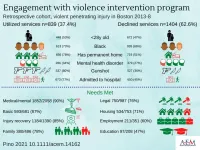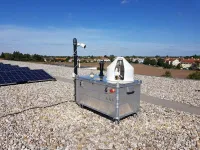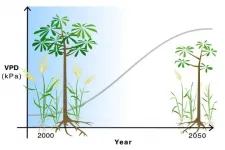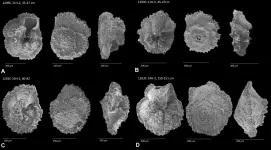(Press-News.org) A team of researchers from the CHUM Research Centre has identified new biomarkers associated with the severity of COVID-19 in infected patients.
Recent scientific literature has shown that the immune response plays a central part in the severity of COVID-19 disease. Understanding the immune responses generated during the course of the disease is therefore essential to determine which patients are at highest risk for serious complications and death from the disease.
In a new study published in the Journal of Clinical Investigation, scientists and clinicians led by Dr.?Catherine Larochelle, researcher at the CHUM Research Centre, have shown that a set of immune alterations are specifically linked to infection with the SARS-CoV-2 virus, as well as to the severity of COVID-19 disease, its 30-day evolution, and its 60-day mortality. These biomarkers could represent potential therapeutic targets.
We have discussed this with Dr. Larochelle, Professor at the Université de Montréal (Department of Neuroscience) and principal author of the study.
Q. Your experimental approach is rather unique. Based on the immune profiling you conducted, how were you able to identify the patients most at risk for a poor prognosis?
Above all, this is the result of a tremendous collective effort by several dozen people involved in research and clinical work at the CHUM, who participated in this study and in the Quebec?COVID-19 (BQC19) Biobank.
Based on a blood test, we were able to inventory the immune cell populations present in 50 patients with SARS-CoV-2 and compare them to those of 22 patients (of similar gender and age) hospitalized for other acute illnesses, and those of 49 healthy controls.
This immune profiling allowed us to identify subsets of "dysregulated" immune cells specific to patients affected by SARS-CoV-2. Most notably, some of these immune alterations were associated with ventilation needs and mortality in these same patients.
These markers specific to SARS-CoV-2 could then help us to identify the patients at greatest risk, and suggest new avenues for developing therapeutic targets.
In addition, we confirm what has been observed in other studies: disturbances in the immune system such as neutrophilia or lymphopenia, for example, are related to the severity of the disease in hospitalized patients, but are not specific to SARS-CoV-2.
From a clinical perspective, this could explain why general anti-inflammatory treatments such as steroids seem to work in COVID-19 and other acute diseases.
Q. How do you see your results being used directly in a clinical setting? Is it technically feasible?
These assays could be easily transferred to clinical settings, because we worked with very small amounts of blood--less than one millilitre--to develop these immune profiles.
In our experimental approach, we used techniques commonly employed in hospital laboratories: use of surface antibodies to "stain" the cells that express certain markers, flow cytometry (cell characterization and counts), etc. In a clinical setting, this could help track the progress of patients over time and ultimately identify those at high risk who would require closer monitoring.
Q. What therapeutic horizons do you envision for your research work?
I hope that our study will lead to the development of biomarkers that will help us stratify patients based on their risk of developing a severe form of the disease. This should also allow us to identify new therapeutic targets, and to better select those patients who might benefit from certain available therapeutic approaches.
INFORMATION:
About the study
The article "Identification of SARS-CoV-2-specific immune alterations in acutely ill patients" by Rose-Marie Rébillard et al., was published Feb. 26, 2021 in the Journal of Clinical Investigation.
Funding for the study was provided by the Fondation du CHUM, the Working Group on Immunity to COVID-19, and the Canadian Institutes of Health Research. BQC19 is an initiative funded by the Fonds de recherche du Québec-Santé, Génome Québec, and the Public Health Agency of Canada in order to better understand the evolution and the determinants of the SARS-CoV-2 infection.
Bacteria integrate genetic material from other bacterial strains more easily than previously thought, which can lead to improved fitness and accelerated evolution. This is shown in a recent study by biophysicists at the University of Cologne. The team analysed genome transfer between bacteria of different lineages. The study was published in the journal PNAS.
In the experiment, the team brought one strain of bacteria into contact with DNA fragments from another strain. The uptake of foreign genetic material is known as horizontal gene transfer -- in contrast to vertical gene transfer, by which genes are inherited from a parent cell of the same lineage. The results show that ...
DES PLAINES, IL - A Boston violence intervention advocacy program is effectively engaging the client population that hospital-based violence intervention programs (HVIPs) have been designed to support. This is the conclusion of a study titled Boston Violence Intervention Advocacy Program: Challenges and Opportunities for Client Engagement and Goal Achievement, to be published in the March 2021 issue of Academic Emergency Medicine (AEM), a journal of the Society for Academic Emergency Medicine (SAEM).
According to the study, HVIPs should consider which types of client needs prove most challenging to address and which novel strategies will engage vulnerable populations not typically targeted by intervention programs. ...
The sensor network MUCCnet (Munich Urban Carbon Column network) consists of five high-precision optical instruments that analyze the sun's light spectra. They measure the concentration of the gases carbon dioxide (CO2), methane (CH4) and carbon monoxide (CO). Since each gas has its own unique spectral "fingerprint", concentrations of these gases can be determined in the columns of air between the instruments and the sun.
"By measuring a vertical column of the atmosphere, local disturbances, such as the disproportionate influence of neighboring stacks, can be removed. Therefore, this type of greenhouse gas balancing is considered particularly robust and accurate," says Prof. Jia Chen.
Measurements at five locations in and around Munich
One of MUCCnet's measurement devices is ...
A new study by the international network Women In Supramolecular Chemistry (WISC) has highlighted the equality, diversity and inclusion (EDI) issues faced by women and marginalised groups working within that field.
The network has also set out a 'calling in' approach to address these issues.
The study, led by Dr Jennifer Leigh and Dr Jennifer Hiscock (both University of Kent) alongside WISC's wider team of international researchers, found that both men and women in the supramolecular community wanted to see more mentoring opportunities and more visibility for women and marginalised groups. There is a desire for more guidance during the transition from postdoctoral researcher to independent Principal Investigator, to ensure women can be retained ...
(COLUMBUS, Ohio) - Concussion, a form of traumatic brain injury, is a common injury among children and teens. Concussions can have adverse effects on physical, cognitive, emotional and sleep health. Clinical guidelines for managing concussion in children and teens traditionally recommend complete physical and cognitive rest until symptom resolution, followed by a gradual return to activities like school and sports. These guidelines are often disputed and based on expert consensus as opposed to strong evidence. The challenge has been how to quantify the amount of physical and cognitive activity that children and teens should engage in during recovery. A new study by researchers at the Center for ...
While cigarette smoking continues to be the leading cause of preventable disease, disability and death in the U.S., the evidence base for cessation support has revealed that telephone call centers, or "quitlines," have been a particularly successful intervention, according to the Centers for Disease Control and Prevention (CDC), which recently published a compilation of scientific research in the American Journal of Preventive Medicine.
Titled "The Role of Quitlines in Tobacco Cessation," the supplement is composed of nine peer-reviewed articles and three commentaries presenting the latest science on quitlines' effectiveness for smoking termination. The compilation demonstrates the relevance and importance of call ...
A global observation of an ongoing atmospheric drying -- known by scientists as a rise in vapor pressure deficit -- has been observed worldwide since the early 2000s. In recent years, this concerning phenomenon has been on the rise, and is predicted to amplify even more in the coming decades as climate change intensifies.
In a new paper published in the journal Global Change Biology, research from the University of Minnesota and Western University in Ontario, Canada, outlines global atmospheric drying significantly reduces productivity of both crops and non-crop plants, even under well-watered conditions. The new findings were established on a large-scale analysis covering 50 years of research and 112 plant species.
"When there ...
Lockdown and other restrictions imposed to control the COVID-19 pandemic have had unseen negative effects on the cognitive capacity and mental health of the population. A study led by the UOC's research group Open Evidence, in collaboration with international universities and BDI Schlseinger Group Market Research, has gauged the impact of the measures taken during the first and second waves of the virus on citizens of three European Union countries. The study concludes that the shock produced by the situation has reduced people's cognitive capacity, leading them to take more risks, ...
Astronomers have discovered new hints of a giant, scorching-hot planet orbiting Vega, one of the brightest stars in the night sky.
The research, published this month in The Astrophysical Journal, was led by University of Colorado Boulder student Spencer Hurt, an undergraduate in the Department of Astrophysical and Planetary Sciences.
It focuses on an iconic and relatively young star, Vega, which is part of the constellation Lyra and has a mass twice that of our own sun. This celestial body sits just 25 light-years, or about 150 trillion miles, from Earth--pretty close, astronomically speaking.
Scientists can also see Vega with telescopes even when it's light out, which makes ...
Microscopic fossilized shells are helping geologists reconstruct Earth's climate during the Paleocene-Eocene Thermal Maximum (PETM), a period of abrupt global warming and ocean acidification that occurred 56 million years ago. Clues from these ancient shells can help scientists better predict future warming and ocean acidification driven by human-caused carbon dioxide emissions.
Led by Northwestern University, the researchers analyzed shells from foraminifera, an ocean-dwelling unicellular organism with an external shell made of calcium carbonate. After analyzing the calcium isotope composition of the fossils, the researchers concluded that massive volcanic activity injected large amounts of carbon dioxide into the Earth system, causing global warming and ocean acidification.
They ...



